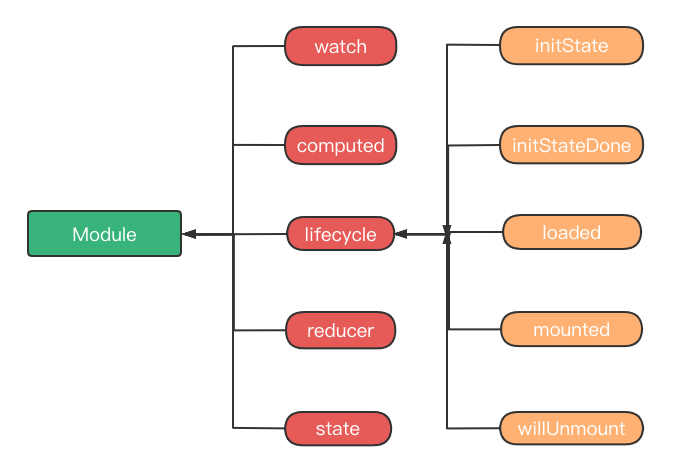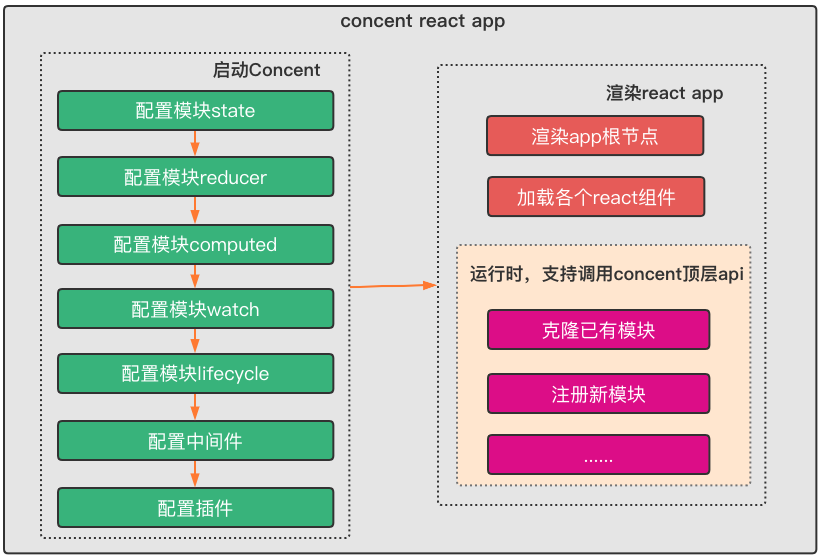模块

在concent里,提供一个全局唯一的store,而store是由多个模块一起组成的,模块是一个非常重要的概念,每个模块又分别由state、reducer、computed、watch、lifecycle组成。
run,载入配置
定义好各个模块后,传递给run接口第一位参数作为启动concent的store配置项,concent启动后会维护这一个全局唯一的ConcentContext对象,里面负责存储各种配置信息,以及暴露底层api接口。
必需先启动concent,才能开始渲染你的react应用根节点,除了
run的调用时机的限制,concent并不需要在你的根app外面包一层Provider来提供store上下文等其他信息,所有的concent组件实例化后都会创建一个RefContext实例上下文对象,所有的实例接口都由RefContext提供。
一个典型的concent应用启动流程如下图所示

伪代码如下
import React, { Component } form 'react';
import { run, useConcent, register } from 'concent';
import reduxDevToolPlugin from 'concent-plugin-redux-devtool';
import loadingPlugin from 'concent-plugin-loading';
const storeConfig = {
foo:{//foo模块定义
state:{},//必填
reducer:{...},//可选
computed:{...},//可选
watch:{...},//可选
lifecycle:{
initState:async()=>{...},//可选
initStateDode:(dispatch, moduleState)=>{...},//可选
loaded:(dispatch, moduleState)=>{...},//可选
mounted:(dispatch, moduleState)=>{...},//可选
willUnmount:(dispatch, moduleState)=>{...},//可选
}
},
bar:{...},
otherModule:{...},
}
//options,可选参数,用于定义其他配置,如中间件、插件等
const options = {
middlewares:[
(stateInfo, next)=>{
console.log(stateInfo);
next();
}
],
plugins:[
loadingPlugin,
reduxDevToolPlugin,
]
};
run(storeConfig, options);
class Foo extends Component{
render(){
const ctx = this.ctx;//实例上下文
// return ui
}
}
const CcFoo = register('foo')(Foo);
function Bar(){
const ctx = useConcent('foo');//实例上下文
// return ui
}
function App(){
return (
<div>
<CcFoo />
<Bar />
</div>
);
}
configure,分离式配置模块
run接口提供了中心化的配置模块统一入口,可以一次性配置多个模块,通常来说business model与业务精密相关,它们的数据会被多个组件共同消费,所以这种中心化式的配置方式适合于集中管理这些业务model,但是page model、component model等model通常是和组件紧密结合在一起的,遵循就近配置的原则方便查看和修改代码,同时也利于按功能或者模型边界组织代码文件结构,所以concent也支持调用configure接口来分离式的配置单个模块定义。
调用
run之后,才能调用configure接口,所以哪怕你没有任何需要中心化配置的模块,你也需要0参数调用run来启动concent。
一个典型的独立配置model的组件文件夹结构
src
├─ ...
└─ page
│ ├─ login
│ │ ├─ model.js
│ │ └─ Login.js
│ └─product
│
└─ component
└─ ConfirmDialog
├─ model.js
└─ index.js推荐进一步将model.js写为文件夹,在内部定义state、reducer、computed、watch、lifecycle,在导出合成在一起组成一个完整的model定义,这样不仅显得各自的职责分明,防止代码膨胀看变成一个巨大的model对象,同时reducer独立定义后,内部函数相互dispatch调用时可以直接基于引用而非字符串了。
src
├─ ...
└─ page
│ ├─ login
│ │ ├─ model //写为文件夹│ │ │ ├─ state.js
│ │ │ ├─ reducer.js
│ │ │ ├─ computed.js
│ │ │ ├─ watch.js
│ │ │ ├─ lifecycle.js
│ │ │ └─ index.js
│ │ └─ Login.js
│ └─ product ...
│
└─ component
└─ ConfirmDialog
├─ model
└─ index.js现在我们可以在 page/login/model/index.js里合成模块并并暴露配置接口.
//code in page/login/model/index.js
import { configure } from 'concent';
import state from './state.js';
import * as reducer from './reducer.js';
import * as computed from './computed.js';
import * as watch from './watch.js';
import lifecycle from './lifecycle.js';
export const loginModule = {state, reducer, computed, watch, lifecycle};
export const configureLoginModule = ()=>{
//配置模块,命名为login
configure('login', loginModule);
}
然后在 page/Login.js里导入模块调用configureLoginModule以便触发configure调用。
//code in page/login/Login.js
import React, { Component } from 'react';
import { register } from 'concent';
import { configureLoginModule } from './model';
configureLoginModule();//触发configure调用
//注册该组件属于login模块
register('login')
export default class Login extends Component{
}模块克隆
如果想创建一个新模块,并复用某个已有模块的全部配置,可以使用cloneModule达到目的。
cloneModule支持对已存在模块重写state、reducer、watch、computed的部分配置,以及替换lifecycle函数,可以根据你的需要来决定是否重写。
import { cloneModule } from 'concent';
import { loginModule } from '/page/login/model';
//完全克隆
cloneModule('ghostLogin', loginModule);
//选择性的覆盖掉某些原配置的克隆
const state = { token:'newInitValue' };
const reducer = {
login(){ ... }
};
cloneModule('anotherGhostLogin', loginModule, { state, reducer });
默认模块
任何不指定模块的组件,会默认属于concent的内置模块$$default,如果你不显式的定义它的配置的话,它是一个空模块。
在不配置
$$default模块的情况下,达到了实例state和模块state相互独立的效果,实例的this.setState将不会触发模块数据变更。
全局模块
concent内置了一个全局模块$$global,如果你不显式的定义它的配置的话,它也是一个空模块。
当你重写它的配置并传递给
run接口后,实例的this.setGlobalState方法和this.globalState属性将很方便的和$$global模块打通,当然你可以定义一个自己的global模块myGlobal,只不过需要自己显式的指定模块名去触发myGlobal模块的数据变更
使用dispatch:this.ctx.dispatch('myGlobal/fooMethod')
使用setModuleState:this.ctx.setModuleState('myGlobal', {name:'1', age:2})